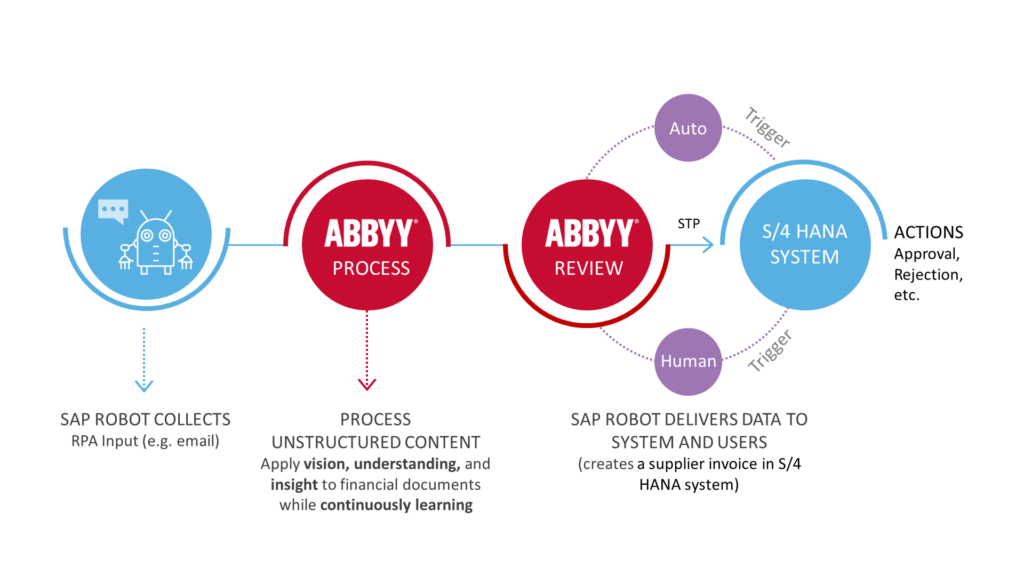Inject Intelligent Document Processing into SAP Intelligent Robotic Process Automation
May 21, 2020

Enterprises today are moving fast in their digital transformation journey, but all have the significant challenge of unlocking key information inside their business documents such as invoices, orders, and other unstructured content. Much of the content from these varied business documents end up in systems like SAP and countless other enterprise systems.
FACT: “92% of the Forbes Global 2000 companies run SAP” SAP Corporate Fact Sheet
A central part to every digital transformation initiative includes robotic process automation (RPA) to automate virtually any structured task that is repeated by humans. This can include interacting with systems like SAP to input data and validate information. SAP Intelligent Robotic Process Automation assists in automating these types of manual tasks in finance, sales & delivery, manufacturing, sourcing & procurement, and professional services to improve company operational efficiency, increase compliance, and lower risk by automating repetitive tasks for employees.
Upskilling Your SAP Robots to Process Documents, Emails, and Unstructured Data
What enterprises have learned over the course of the past couple years is RPA needs assistance in automating processes involving documents, emails and other unstructured data. Think of it as adding intelligence to an SAP robot, where the robot is equipped with the necessary digital skills that apply vision, understanding, and insight to the robotic process so that a robot can process a document like an invoice, purchase order, or bill of lading. The cognitive skill is trained software that can be invoked by the SAP robot, where the skill would identify the document as an invoice, locate and extract the header, footer, and line item details, structure and validate the data, before handing the data back to the robot for processing in SAP.
The following diagram illustrates the general process flow between SAP Intelligent RPA and ABBYY.

A common misconception is its just OCR, which completely misses the mark on what is really happening. Another preconceived notion is that templates are required for each variation of a document like the different vendor invoices. I’m here to tell you that is false and that would be an exercise of futility which would fail miserably.
A better way to think of what is happening when a document is processed is to consider the intelligence of automating in the words of vision, understanding, and insight.
Vision – Ability to digitize text in a document, apply image analysis to optimize readability of an image, and analyze the structural makeup of a document by segmenting words, phrases, sentences, and paragraphs.
Understanding – Applying machine learning to train a project to classify a document type and extract data. The software learns from the initial training set of documents, and learning improves overtime as the training set expands and statistics are collected at runtime during human-in-the-loop verification. In the case of invoices, ABBYY delivers a pre-trained model that enterprises start with.
Insight – Applying structure and meaning around the text to mimic human judgment like establishing the relationship between data (e.g. buyer vs. seller).
“AI technology – including Machine Learning (ML), Natural Language Processing (NLP) and computer vision – used in combination with RPA has the potential to unlock significantly greater business benefits than that achievable through standalone RPA. The combination can help automate not just the transactional portions of processes but also the judgment-intensive ones.”
Anil Vijayan, Practice Director, Service Optimization Technologies at Everest Group
Leading the Way in Intelligent Document Processing
ABBYY’s intelligent document processing platform (IDP) was recently positioned as a leader in the Everest Group Intelligent Document Processing (IDP) Peak Matrix Assessment 2020. ABBYY garnered the highest position on the axis for Vision & Capability which measures, among other factors, the company’s vision and strategy, product capabilities, and the progressiveness and flexibility of its commercial models.
When you combine ABBYY’s leading IDP offering with SAP Intelligent RPA, ABBYY’s intelligent document processing platform provides the cognitive skills required to assist in automating content-centric processes. IDP is truly changing the way enterprises work by powering the new digital workforce with the skills and understanding needed to make intelligent business decisions.
Next Steps
If you are an SAP customer who’s using or interested in evaluating the SAP Intelligence RPA solution, now is the time to learn more about the combined offering of SAP Intelligent RPA and ABBYY FlexiCapture.
Join us for the upcoming webinar on June 3rd, as ABBYY and SAP team up for an interactive discussion and demonstration of the combined solution.
You can also learn more by visiting the SAP Community to see the latest technical blog post – How to Combine SAP Intelligent RPA with ABBYY FlexiCapture. If you already have a license of SAP Intelligent RPA and ABBYY FlexiCapture, you can download the connector from the SAP Intelligent RPA Store.
Subscribe for blog updates
- Understanding FSQS Certification and Its Importance for Financial Institutions
- Document Automation as Game-Changer across Industries
- ABBYY DevCon Hackathon 2025 Doubles Down on AI Innovation
